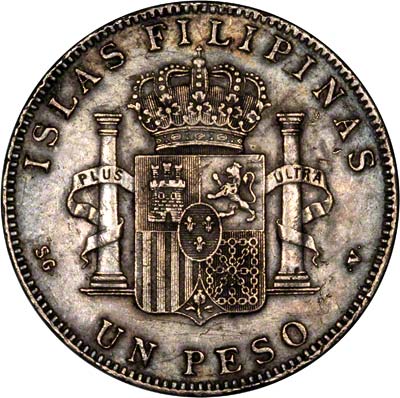| The Very Highest Quality Information... |
| Philippine Coins |
|
| ||||||||||||||||||||||||||||||||||||
 | ||||||||||||||||||||||||||||||||||||
|
| ||||||||||||||||||||||||||||||||||||

| ||||||||||||||||||||||||||||||||||||
Coinage of the Philippines
The earliest coins of the Philippines were tiny gold piloncitos (which do not look too dissimi-lar to Indian gold Fanams) used for trade amongst the early pre-Spanish Filipinos. The arrival of the Spanish in 1521 saw the introduction of Spanish currency to the archipelago, chiefly based around the silver teston, or four-reale piece. Later, the Spanish 8 Reale Piece of 8 (known colloquially as the ‘Peso’) became the standard unit of currency.
The decimalisation of Spanish Currency in the middle of the 19th Century eventually saw a similar reform in the Philippines. In 1861, a mint was established by the Spanish in Manila for the specific purpose of supplying the colony with coinage, and the Philippines was fully converted to decimal currency in 1864, with a currency consisting of a Peso sub dividable into 100 Centimos.
The Spanish-Filipino Peso was de-monetised in 1904 in favour of a US-Philippine Peso, which was subdivided into 100 Centavos. The American coat of arms subsequently graced the obverse of Filipino currency until independence in 1946.
Rapid inflation post-war saw the removal of precious metal coinage in 1958. Since the 1960s, the coinage of the Philippines has been struck in the native Tagalog language, rather than Spanish, which is no longer an official language within the Philippines. The local name for the peso is ‘piso’, but is still known outside of the country as the ‘peso’.
For Sale and Wanted
If you are interested in coins from the Philippines please see our product index:-
Philippine Coins
Gold Coins
We also have gold coins from the Philippines on our taxfreegold website:-
Philippine Gold Coins
| ...at the Lowest Possible Price |
|
32 - 36 Harrowside, Blackpool, Lancashire, FY4 1RJ, England.
Telephone (44) - (0) 1253 - 343081 ; Fax 408058; E-mail: info@chards.co.uk The URL for our main page is: https://24carat.co.uk |
Web Design by Snoop |